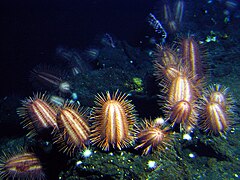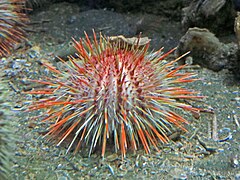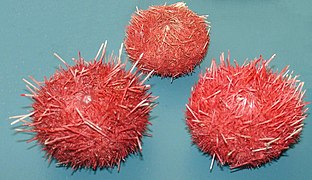
Echinus esculentus, the European edible sea urchin or common sea urchin, is a species of marine invertebrate in the Echinidae family. It is found in coastal areas of western Europe down to a depth of 1,200 m (3,900 ft). It is considered "Near threatened" in the IUCN Red List of Threatened Species.

Echinus is a genus of sea urchins. Sea urchins are echinoderms that are typically spherical or flattened with a covering of spine-like structures. Sea urchins tend to be important members of their ecosystems by grazing on other organisms and stabilizing populations. In addition to this, sea urchins play a large role in different economies globally as the urchin themselves and their roe are sold for consumption. The same is true for the species within the genus Echinus.

Echinoida is an order of sea urchins in the class Echinoidea. They are distinguished from other sea urchins by simultaneously possessing both an un-sculpted test and a feeding lantern with large plates fused across the top of each pyramid.

Echinus tylodes is a species of sea urchin in the Echinidae family. It is white with rather sparse pink spines, and is endemic to the eastern coast of North America including the Gulf of Mexico.

Temnopleuridea is an infraorder of sea urchins in the order Camarodonta. They are distinguished from other sea urchins by the presence of large fused plates on top of the feeding lantern. The test is usually sculpted to some degree, and has perforated tubercles.

The Echinothurioida are an order of sea urchins in the class Echinoidea. Echinothurioids are distinguished from other sea urchins by the combination of a flexible test and hollow spines. The membrane around the mouth contains only simple plates, in contrast to the more complex mouth parts of their close relatives, the Diadematoida. They are nearly all deepsea dwellers.

Cidaroida is an order of primitive sea urchins, the only living order of the subclass Perischoechinoidea. All other orders of this subclass, which were even more primitive than the living forms, became extinct during the Mesozoic.

Cidaridae is a family of sea urchins in the order Cidaroida.

Toxopneustidae is a family of globular sea urchins in the class Echinoidea.

The Camarodonta are an order of globular sea urchins in the class Echinoidea. The fossil record shows that camarodonts have been in existence since the Lower Cretaceous.

Psychocidaridae is a family of sea urchins in the order Cidaroida. The genus Psychocidaris is extant while the other genera are only known from fossils. The family has been in existence since the Lower Jurassic (Toarcian) and the range includes Europe, Ukraine, North America, North Africa and the West Pacific.

Echinus melo, melon sea urchin, is a species of sea urchin in the family Echinidae.

Sterechinus is a genus of sea urchins in the family Echinidae. All living members of the genus are found in the waters around Antarctica but the first species described in the genus was a fossil and was found in Europe.

Sterechinus neumayeri, the Antarctic sea urchin, is a species of sea urchin in the family Echinidae. It is found living on the seabed in the waters around Antarctica. It has been used as a model organism in the fields of reproductive biology, embryology, ecology, physiology and toxicology.

Psammechinus microtuberculatus, also known as the green sea urchin, in the family Parechinidae. It was formerly known as Echinus microtuberculatus, and thought to be of the genus Echinus.

Eucidaris is a genus of cidaroid sea urchins known as slate pencil urchins. They are characterised by a moderately thick test, a usually monocyclic apical disc, perforate and non-crenulate tubercles and nearly straight ambulacra with horizontal pore pairs. The primary spines are few and widely spaced, stout with blunt flat tips and beaded ornamentation and the secondary spines are short and apressed. They originated in the Miocene and extant members of the genus are found in the tropical Indo-Pacific Ocean, East Pacific, Atlantic Ocean and Caribbean Sea.

Echinus gilchristi, common name Gilchrist's sea urchin, is a species of marine invertebrate in the Echinidae family that usually grows to a diameter of 10 cm.

Gracilechinus acutus is a species of sea urchin in the family Echinidae, commonly known as the white sea urchin. It is an omnivore and feeds on algae and small invertebrates.

Gracilechinus is a genus of sea urchins in the family Echinidae.

Dermechinus is a genus of sea urchin in the family Echinidae found in deep water in the southern Indian, Pacific and Atlantic Oceans. It is monotypic, with Dermechinus horridus, sometimes called the cactus urchin, being the only species.



















